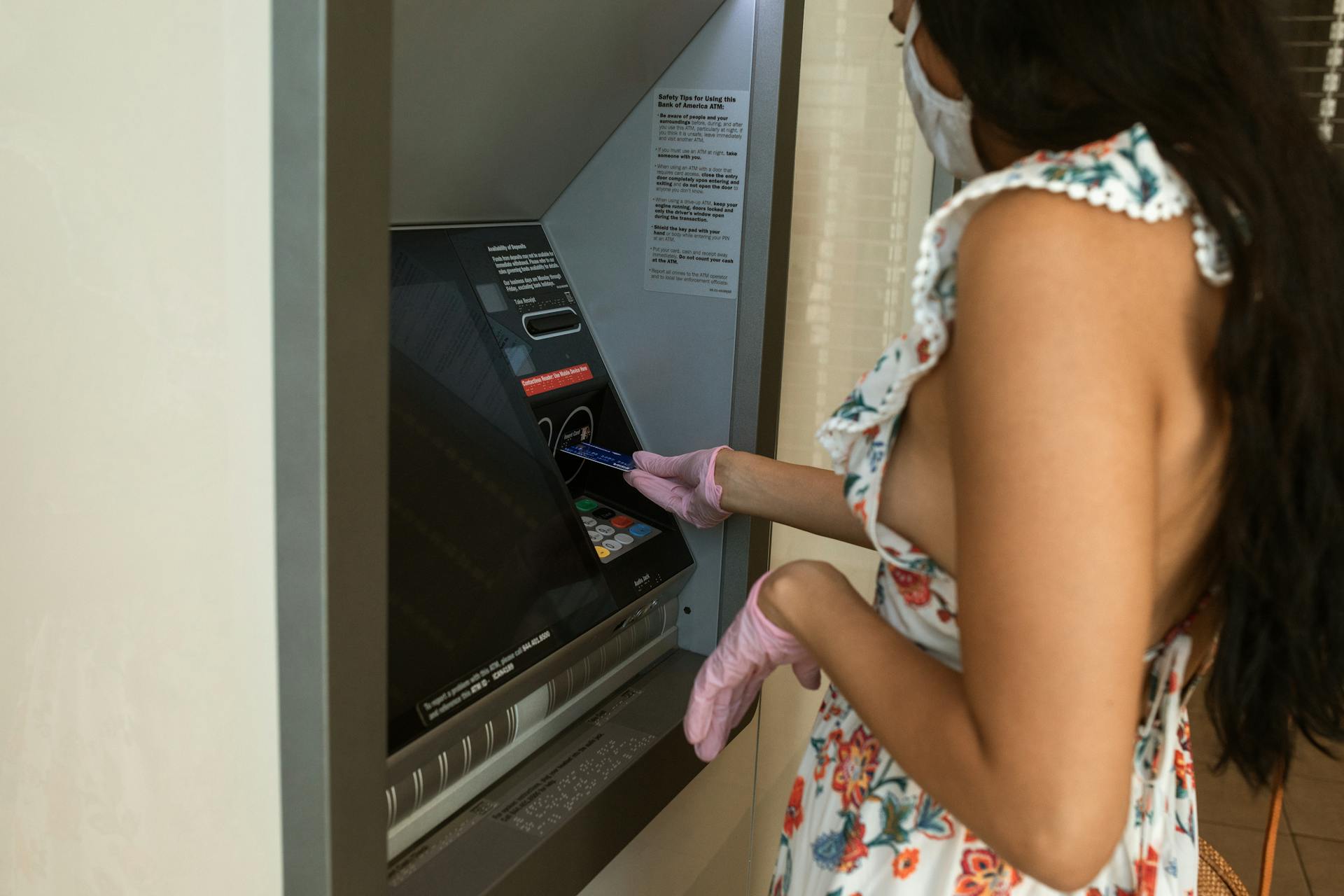
Cash-flow return on investment (CFROI) is a financial metric that measures a company's profitability by comparing its cash flow to its invested capital.
CFROI is calculated by dividing a company's operating cash flow by its invested capital.
This metric provides a clear picture of a company's ability to generate cash from its investments, helping investors make informed decisions.
A higher CFROI indicates a company's ability to generate more cash from its investments, which is a sign of good financial health.
A CFROI of 10% or higher is generally considered good, while a CFROI below 5% may indicate financial struggles.
Here's an interesting read: Cash Return on Capital Invested
What Is Cash-Flow Return on Investment?
Cash-flow return on investment (CFROI) is a metric that measures a company's profitability based on its cash flows, not just its earnings. This is a key difference from traditional return on investment (ROI) metrics.
CFROI takes into account the time value of money, making it a more accurate representation of a company's financial health. It does this by using a discount rate to calculate the present value of future cash flows.
For another approach, see: The Current Ratio Measures a Company's
A company's CFROI can be influenced by factors such as its industry, business model, and level of debt. For example, a company with high levels of debt may have a lower CFROI due to the interest payments it must make.
CFROI can also be used to compare the performance of different companies within the same industry. This can help investors and analysts identify which companies are generating the most value from their cash flows.
Calculating
Calculating CFROI is a straightforward process. To start, you need to determine the gross cash flow of the company by adding back non-cash expenses like depreciation and amortization to the net income.
The next step is to calculate the total invested capital by adding together the company's equity capital and debt capital. This includes common and preferred shares, as well as interest-bearing debt.
To calculate the gross cash flow, you can use the following formula: Gross Cash Flow = Net Income + Non-cash Expenses. Non-cash expenses include depreciation and amortization.
Curious to learn more? Check out: How to Calculate Debt to Income Ratio with Student Loans
Here's a step-by-step guide to calculating CFROI:
- Calculate Gross Cash Flow: Start by determining the company's net income, then add back non-cash expenses.
- Calculate Gross Investment: Determine the total capital invested in the company, including equity capital and debt.
- Calculate CFROI: Divide the gross cash flow by the gross investment and multiply by 100.
The CFROI formula is also represented as: CFROI = Operating Cash Flow (OCF) / Capital Employed. To use this formula, you need to understand both OCF and CE.
Here are the key components of the CFROI formula:
- Gross Cash Flow: The cash generated by the company's operations before interest expenses and taxes.
- Gross Investment: The total capital invested in the company, including equity capital and debt.
By following these steps and using the CFROI formula, you can accurately calculate the cash-flow return on investment for a company.
Interpreting Cash-Flow Return on Investment
A high CFROI indicates that a company is generating a high cash flow relative to the capital invested, which is generally seen as a positive sign.
This means the company is efficiently using its capital to generate cash flow, which is a good sign for investors.
On the other hand, a low CFROI indicates that a company is generating a low cash flow relative to the capital invested, which could be a sign of inefficiency.
A low CFROI doesn't necessarily mean the company is doing poorly, as it could also indicate that the company is in a capital-intensive industry.
Readers also liked: Current Ratio Meaning High and Low
To interpret CFROI, you need to compare it to the Weighted Average Cost of Capital (WACC), which is the hurdle rate.
If the Net CFROI is positive (i.e., Net CFROI > WACC), it means the company is increasing the value of shareholders.
Here's a summary of how to interpret Net CFROI:
Key Concepts and Considerations
CFROI assumes that the financial markets set prices based on a company's cash flow, rather than earnings or other metrics. This approach gives investors a deeper understanding of how a company generates cash and manages its finances.
The CFROI formula is relatively simple, using the ratio of operating cash flow to capital employed. This means it considers both equity capital and debt capital in its calculations. Capital employed includes total equity, short-term debt, capital lease obligations, and long-term debt.
CFROI provides a clean comparison basis for historical analysis of a company's value creation or destruction over time, by removing distortions in a company's income statement and balance sheet. It also accounts for inflation, giving a more accurate picture of a company's financial health.
For another approach, see: Return on Capital Employed
Key Considerations
When evaluating a rental property, it's essential to consider the cash flow return on investment (CFROI). This metric provides a clear picture of a company's financial health and can be used to compare company performance with peers.
CFROI takes into account the capital invested in the company, considering both equity capital provided by shareholders and debt capital provided by lenders. This is a more comprehensive view of a company's return on investment.
A high CFROI indicates that a company is generating strong cash flows relative to its cost of capital. However, it's also essential to consider the capital intensity of a company's industry, as companies in capital-intensive industries may have lower CFROIs.
Here are some key factors to consider when evaluating a rental property:
- Capitalization rate: This is the ratio of net operating income (NOI) to the investment asset value or current market value.
- Internal rate of return (IRR): This is an annual rate earned on each dollar invested for the period it is invested.
- Time value of money: This is essential to consider when evaluating the profitability of a rental property.
- Growth prospects: A company with a high CFROI but low growth prospects may not be a good investment.
- Capital intensity: Companies in capital-intensive industries may have lower CFROIs, but this doesn't necessarily mean they are less profitable.
- Cash flow generation: This is a critical aspect of CFROI, as it provides a clear picture of a company's financial health.
By considering these factors, you can get a more comprehensive view of a rental property's potential return on investment and make informed decisions about your investments.
Market Valuation
Market Valuation is a crucial aspect of investing, and CFROI is a key metric in assessing it. By comparing the market's CFROI to the return on a risk-free investment, traders can gain insight into whether the market is overvalued or undervalued.

If the market's CFROI is significantly higher than the return on a risk-free investment, it could indicate that the market is overvalued. This means investors may be overpaying for stocks, and a correction is likely.
Conversely, if the market's CFROI is significantly lower, it could indicate that the market is undervalued. This presents an opportunity for investors to buy stocks at a lower price and potentially earn higher returns in the long run.
Calculating and Interpreting Cash-Flow Return on Investment
Calculating Cash-Flow Return on Investment (CFROI) involves a few simple steps. You start by calculating the gross cash flow of the company, which is done by adding back non-cash expenses like depreciation and amortization to the net income.
To calculate the gross cash flow, you need to start with the company's net income, which can be found on the income statement. You then add back any non-cash expenses like depreciation and amortization, also found on the income statement.
Discover more: Does Life Insurance Cover Burial Expenses

Next, you calculate the total invested capital by adding together the company's equity capital and debt capital. This information can be found on the balance sheet.
The final step is to calculate the CFROI by dividing the gross cash flow by the total invested capital and multiplying by 100.
A high CFROI indicates that the company is generating a high cash flow relative to the capital invested, which is generally seen as a positive sign. This means the company is efficiently using its capital to generate cash flow.
On the other hand, a low CFROI indicates that the company is generating a low cash flow relative to the capital invested, which could be a sign of inefficiency or a capital-intensive industry.
Here's a simple formula to calculate CFROI:
CFROI = (Gross Cash Flow / Total Invested Capital) x 100
This formula helps you quickly determine the CFROI of a company, giving you a clear picture of its financial performance.
If this caught your attention, see: Low Expense Ratio Etfs
Limitations and Risks

Cash-flow return on investment (CFROI) is a useful tool, but it's not perfect. One of its limitations is that it's based on cash flow, which can be influenced by a company's cash management practices.
A company could increase its cash flow by delaying payments to suppliers or speeding up collections from customers, which would artificially boost its CFROI. This doesn't necessarily mean the company's underlying business performance has improved.
Risk Assessment
A company with a stable or increasing CFROI over time is generally seen as less risky than a company with a fluctuating or decreasing CFROI.
A high CFROI indicates that the company is generating a high cash flow relative to the capital invested, which can help the company weather financial difficulties.
CFROI can also be used as a tool for risk assessment, making it a valuable metric for investors and analysts.
A company with a high CFROI is generally seen as less risky than a company with a low CFROI, as it suggests the company is more financially resilient.
Explore further: Accounting Profits and Cash Flows Are Generally
Limitations

CFROI is a useful tool for assessing a company's financial performance, but it's not without its limitations.
One limitation is that CFROI is based on cash flow, which can be influenced by a company's cash management practices. A company could increase its cash flow by delaying payments to suppliers or speeding up collections from customers.
This would increase the company's CFROI, but it wouldn't necessarily indicate an improvement in the company's underlying business performance. It's like trying to hide a problem by temporarily manipulating numbers – it won't solve the root issue.
Featured Images: pexels.com

